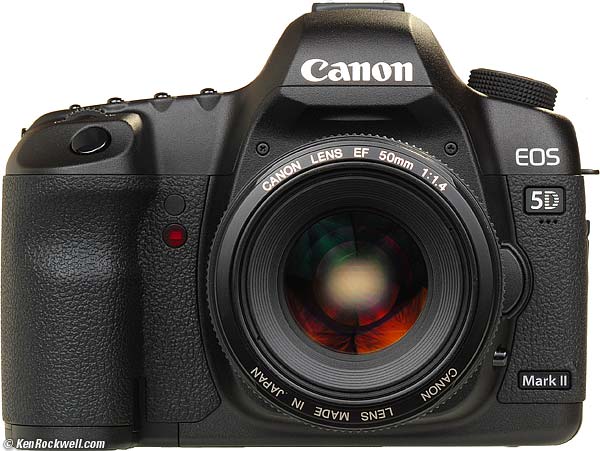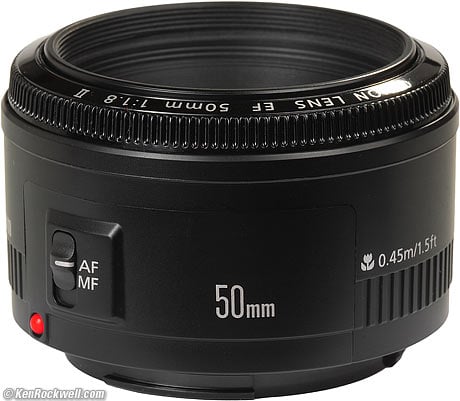Home Donate New Search Gallery How-To Books Links Workshops About Contact
Canon
5D Mark II
Lenses
© 2010 KenRockwell.com. All rights reserved.
5D Mk II Review Specs Performance Compared Usage Recommendations
Diagrams What's New What's Old Sales Fluff Lenses Video
Canon 5D Mark II and 50mm f/1.4. enlarge.
May 2010 More Canon Reviews Canon lens reviews
|
Adorama pays top dollar for your used gear. I use these stores. I can't vouch for ads below. |
What I use
I use the Canon 28mm f/1.8, Canon 50mm f/1.8 and Canon 100mm f/2, and that's it.
Most normal people use the Canon 17-40mm, Canon 24-105 and Canon 70-200 f/4 L IS zooms.
I shoot those zooms, too, on occasion, but the fixed lenses are sharper, lighter, faster, smaller and less expensive.
The 16-35mm f/2.8 L II is also popular, instead of the 17-40mm.
If you're shooting zooms, don't bring all three. If you're bringing a 24-105, leave the other two at home. I'd pass on the older 24-70mm f/2.8 L; it's not as sharp as the 24-105mm if you want your pixel's worth on the 5D Mark II.
If you're shooting a wide and a tele zoom, leave the midrange zoom at home. Why? because you never want to duplicate any part of the zoom range; it makes you carry too much.
More at Assembling a System.
High Resolution
The 5D Mark II has such high resolution that you'll need extraordinary lenses to make the best use of all its pixels. Canon's pro fixed f/2.8 super teles are great, but the state-of-the-art in Canon wide zooms isn't there yet.
Mediocre lenses will work at least as well on the 5D Mark II as the 5D or older cameras, however the 5D Mark II's high resolution will make any lens limitations more visible. To get the most out of a high-resolution camera, you need the best lenses you can get.
Good lenses don't have to be expensive; the $100 Canon 50mm f/1.8 is one of the sharpest lenses I own.
For normal use you can ignore this, but if you're a tweaker who spends more time looking at your images at 100% than looking at your pictures, you're going to need to be very careful with your selection of aperture. Diffraction becomes obvious at f/11 and smaller. For instance, with the sharpest zoom I've ever used, the 70-200 f/4 IS L, it's obvious, shooting at infinity, that the optimum aperture is f/8 at all focal lengths. Use a so-so lens, like the plastic EF 70-300 f/4-5.6 III, and you'd better stop it down to f/8 ~ 11 and not use it at longer than 135mm.
The 50 1.4 USM is great, but again, optimum at f/8 and f/11.
The 28-135mm IS is OK at 50mm at f/8-f/11. At 28mm you have a lot of lateral color fringes, and it gets softer much longer than 70mm.
The original EF 14mm f/2.8 L has loads of lateral color, and is optimum at f/11. This will be greatly improved if DxO makes a module for it. Don't buy a 5D Mark II for the original 14mm; it's not sharp enough to make it worth your while.
The excellent Canon 15mm fisheye is very good. It has some lateral color, and is optimum at f/8.
The 16-35mm II can look awful, since it, like the 14mm lens, has never been as sharp as normal and long lenses. It's best at f/11. I discovered that I get much better results using just the one center AF sensor, since using all the AF sensors at the same time giver poorer results. This had me chasing the forbidden AF tweak controls, until I realized that I probably was chasing a field curvature issue instead.
The 17-40mm is as good as the 16-35mm II. It's not pretty if you're looking too close. Best aperture is f/8~11.
It just might be time to shoot Nikon (or Zeiss) manual focus lenses on the 5D Mark II if you're a tweaker. I popped on a Nikon 105mm f/4 AI-s Micro-NIKKOR with a kludge adapter, and it worked great, without any of the alignment issues of AF lenses caused by mechanical slop.
For a fantastic lens cheap, get a $100 Canon 50mm f/1.8 II. Its performance is better than most Canon normal, wide and zoom lenses, even "L" series.
The most obvious defect beyond the corner fuzziness visible at high print magnifications in many Canon wide and normal zoom lenses, even the L series, on the 5D Mark II is lateral color. On many lenses as noted in my reviews, you'll see green-magenta color fringes in the sides and corners, and this often is visible in even normal sized prints if you're picky. This isn't the 5D Mark II's fault; the 5D Mark II's high resolution makes these lens limitations obvious. (Nikon's current DSLRs automatically correct these color fringes, but not Canon.)
Help me help you top
I support my growing family through this website, as crazy as it might seem.
If you find this as helpful as a book you might have had to buy or a workshop you may have had to take, feel free to help me continue helping everyone.
If you've gotten your gear through one of my links or helped otherwise, you're family. It's great people like you who allow me to keep adding to this site full-time. Thanks!
If you haven't helped yet, please do, and consider helping me with a gift of $5.00.
The biggest help is to use these links to Adorama, Amazon, B&H and eBay the other places have the best prices and service, which is why I've used them since before this website existed. I recommend them all personally.
Thanks for reading!
Ken
Home Donate New Search Gallery How-To Books Links Workshops About Contact




